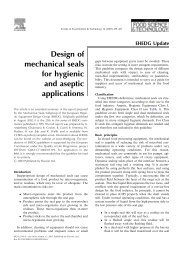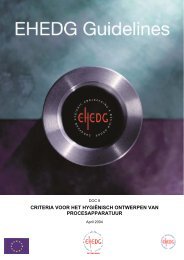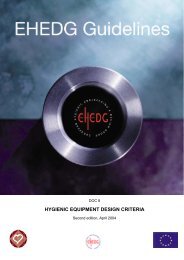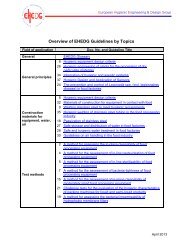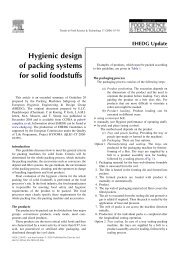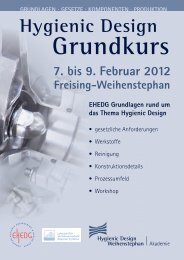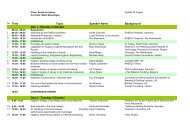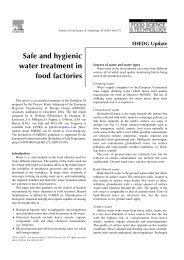Yearbook 2013/2014 - ehedg
Yearbook 2013/2014 - ehedg
Yearbook 2013/2014 - ehedg
You also want an ePaper? Increase the reach of your titles
YUMPU automatically turns print PDFs into web optimized ePapers that Google loves.
74 Optimisation of tank cleaning<br />
Real-time tank cleaning process control<br />
Process control depends upon reliable real-time in-line<br />
measurements using electronic sensors, such as the<br />
Rotacheck sensor, to monitor and verify the performance of<br />
a rotary jet head and tank CIP. Various such devices are<br />
readily available today. However, it is important to consider<br />
the response time of the device, as well as its ability to<br />
register the actual pressure at which the jets hit the tank<br />
surface.<br />
Fast response time is critical in order to measure the impact<br />
force of the water jets accurately and reliably. A response<br />
time of less than 25 ms is considered necessary to register<br />
a jet hit against the tank wall; however, the response time for<br />
many sensors is too long, exceeding the 25 ms and therefore<br />
providing inaccurate measurements. Consequently, the<br />
sensors do not measure the entire actual impact and<br />
therefore do not properly validate the effect of the jet.<br />
Furthermore, the signal remains “high” on the sensor even<br />
after the jet has passed and is no longer hitting the sensor.<br />
Registering the actual pressure at which the jet hits the tank<br />
surface is equally important. This pressure is the actual<br />
impact force that the jet exerts upon the tank surface. If the<br />
amount of pressure applied to the tank surface decreases,<br />
then the impact force decreases as well (Fig. 8). As the<br />
pressure decreases so too does cleaning efficiency, which<br />
consequently causes the cleaning time to increase.<br />
Advanced sensors, such as the Rotacheck+ version that<br />
carries the 3-A symbol and has been EHEDG-certified, offer<br />
the same advantages as basic sensors but include built-in<br />
intelligence. This consists of a teach-in function where the<br />
sensor records and stores the unique and actual cleaning<br />
pattern for any individual tank cleaning machine based upon<br />
its initial cleaning cycle, which has the design parameters<br />
(set point) intact.<br />
Every time a CIP process is initiated thereafter, the sensor will<br />
compare the actual measurements to the recorded pattern<br />
(set point). Operators are immediately alerted during tank<br />
CIP if there is any deviation from the initially recorded time,<br />
pressure or registration of jet hits. This enables operators to<br />
act immediately to remedy the situation, thereby reducing<br />
the risk of losing valuable production time. With the right CIP<br />
sensor in place, the process is under control.<br />
Figure 9. EHEDG certified Electronic verification tools, such as the<br />
Rotacheck and Rotacheck+ sensors, validate the proper function of<br />
rotary jet heads during tank cleaning.<br />
Figure 8. Jet impact profile of a rotary jet head when passing a<br />
Rotacheck sensor. Typical pressure characteristics of a water jet<br />
from a rotary jet heat at 3 bar and at 5 bar shown.<br />
Selection of the right CIP process control<br />
system<br />
Choosing the right system to monitor and control tank CIP<br />
processes can be challenging. It is important to define your<br />
objectives for monitoring and control and to understand the<br />
available options and advantages.<br />
Basic sensors transmit a simple logic signal to the plant’s<br />
control system, which indicates all jet hits and verifies<br />
the operation of the rotary jet head. In addition to signal<br />
transmission, some sensors also have a clear visual light<br />
signal that is visible to operators on the plant floor. Most are<br />
easy to install anywhere on the tank, even on a pressurised<br />
tank.<br />
Tank CIP process control optimises plant<br />
hygiene and efficiency<br />
There are several ways to achieve optimal tank cleaning<br />
efficiency. To determine the right tank cleaning method for<br />
a particular process, it is important to define the cleaning<br />
criteria, understand the options available and consider the<br />
level of cleaning efficiency and process control required.<br />
Selecting the right tank cleaning method puts the food<br />
manufacturer in control of the tank cleaning process and<br />
ensures that the best cleaning results can be achieved in<br />
terms of accuracy, reliability and repeatability.<br />
Whilst manual tank cleaning may seem sufficient for<br />
some processes, there are advantages to switching to an<br />
automated system, including cleaning consistency, reduced<br />
labour costs and increased production time. Enhancing<br />
automated tank cleaning processes also has its advantages<br />
in terms of less downtime, higher energy savings and<br />
reduced water and cleaning fluid consumption.



